One of the joys that I have when doing research into the fraud of germ “theory” and virology is stumbling upon hidden gems of information attached to buried and forgotten voices that highlight the fallacious premises behind the belief that invisible germs cause disease. I absolutely love being able to present the words of the past back to the public in order for the absolutely vital information to be rediscovered and redistributed. I am in the fortunate position to give the voices back to the brave people who spoke out at the dawn of the germ “theory” who were sadly not heard by a public that needed to hear what they had to say during their own lifetime.
In order to do so, I have found that one of the best ways to reclaim these words of wisdom is by combing through old newspaper articles from the late 19th and early 20th century, a time when the germ “theory” had not yet gained the dogmatic position that it now holds. This was a time when the emerging pharmaceutical industry had less influence over what was allowed to be printed within the press. Individuals from all walks of life, including credentialed scientists, respected physicians, and general laypeople, were able to freely voice their opinions and highlight the logical fallacies and lack of scientific evidence supporting the growing pseudoscientific threat. Incredibly, physicians such as Dr. Thomas Powell and Dr. John Bell Fraser were able to discuss the results of their own experiments that falsified the germ “theory” of disease, allowing their evidence to be presented in articles that were distributed far across the United States, Canada, Europe, and even in Australia. Fortunately, they were not the only ones who stood tall in the face of the manufactured “scientific” consensus. During this period, many individuals recognized the logical errors and the absence of genuine scientific practice, and they were equally willing to risk their hard-earned reputations to raise the alarm..
As I am a firm believer in learning from the past lest we are doomed to continue repeating the mistakes endlessly, I am happy to present even more of these courageous voices that were amongst the opposition to the fallacious germ “theory.” What you will find below are many examples of those who openly challenged Louis Pasteur and Robert Koch over the lack of scientific evidence supporting the germ “theory” of disease. Pasteur was hit particularly hard over the fallacious evidence that he had presented for hydrophobia, a.k.a. rabies, that he used to support his toxic injections which created a disease that had not existed before. Even his own countrymen, including many prominent physicians, called out Pasteur's fraudulent claims. Amongst the prominent and respected physicians calling out the germ “theory” of disease was Dr. Walter Hadwen, a member of the Royal Society of Physicians and Surgeons, a group considered to be made up of the most distinguished physicians in the world.
The above quote speaks to the kind of man that Dr. Hadwen was: a man willing to challenge his preconceived beliefs through critical thinking and logic. His scathing rebukes of the germ “theory” are featured prominently in a few articles. There are many other voices presented that joined the chorus against the emerging fraud such as Dr. John Tuitt, Dr. J. M. Crawford, Dr. William H. Holcombe, Dr. J. W. Hodge, Dr. Stanford Claunch, American nutrionist Professor Bernarr McFadden, Henry Bergh, and Dr. George Wilson, M.D. L.L.D., a Royal Commissioner. These men all provided valuable nuggets of information against the pseudoscientific work championed by the germ “theorists.” Also included are a few articles discussing another germ duel challenge that was issued in the early 1920s. My hope is that, by giving these remarkable individuals the chance to be heard once again, you are able to come away with an even greater understanding of the germ hoax that has been perpetrated on us over the last few centuries.
The Indianapolis Journal January 17, 1886
This first short clip from 1886 was interesting not simply because the physicians of Philadelphia collectively decided that Louis Pasteur was a fraud, but also due to the challenge by the author to have them all sent to Paris to be inoculated for (not with) rabies which was said would invariably lead to symptoms and death.
The Meriden Daily Republican July 23, 1886
Henry Bergh, the focus of this article, founded two important organizations in his lifetime. The first was the American Society for the Prevention of Cruelty to Animals (ASPCA) in April, 1866 which was established in order to help save animals from cruelty, such as when being used to turn hot grills in restaurants. The second organization was the New York Society for the Prevention of Cruelty to Children (MSPCC) in 1874 which was established in order to protect the African-American children who had replaced the dogs. Needless to say, Bergh was opposed to Pasteur and the harmful practice of vaccination for hydrophobia, a.k.a. rabies. He argued that there was nothing more absurd than taking a “virus” (meaning poison at the time) from an unhealthy person and injecting this into a healthy one. As an apt comparison, he asked, “Can you prevent corruption by inoculating with corruption?” Bergh noted that diseases were increasing with the use of vaccination, rather than decreasing as claimed. He predicted that the fraudulent “theory” would be used for all diseases, and lamented that children were being turned away from getting a proper education without vaccination. Bergh questioned whether Pasteur had ever “cured” anyone of rabies, and stated that the “great scientist” had been “pulling the wool over the eyes of his countrymen.”
The South Bend Tribune July 27, 1886
Interestingly, many of Pasteur's own countrymen were able to see past the wool, denouncing him as a fraud in what was described as a “largely attended meeting” of physicians who objected to his methods and system.
The Stark Coutny Democrat July 29, 1886
In fact, not only did they announce Pasteur as a fraud, the doctors described his experiments as “humbug,” which, for those not fluent in 19th century insults, meant “deceptive or false talk or behavior” according to the Oxford Lanuage Dictionary.
The Morning Call September 5, 1886
A dog-fancier stated that dogs are regularly subject to “fits” that will pass if they are left alone. Rabies was a disease produced by fear, both in the dogs and in the humans. The fancier, named Fourfoot (must have been short) was quoted stating “Hydrophobia is a fraud and Pasteur is a humbug,” which was in complete agreement with the opinions of Pasteur's own countrymen and the physicians from Philadelphia.
The Concordia Blade October 7, 1887
A year later, things were not looking any better for Pasteur in Paris. It was stated that his system of inoculation for rabies was being constantly attacked there, to the point that the law was invoked in order to stop him from committing murder daily with his injections. The Academy of Medicine denounced Pasteur and he was expelled from at least two different medical societies. French physician Monseiur Michel Peter, a member of the Academy of Medicine, contended that Pasteur's germ “theory” was a “delusion and a snare,” that he was a “fraud” and a “nuisance,” that his “so-called science” was a “cheat and a juggle,” and that at best, Pasteur was an “inferior” chemist. This attack on Pasteur was brought about due to the death of one of his patients from the rabies vaccine.
Regardless, Dr. Bronardel came to Pasteur's defense claiming that the treatment had worked in cases of “true hydrophobia.” An example was provided, claiming that an English commission had experimented on ninety persons bitten by supposedly rabid animals, losing only four. However, the argument could have easily been made that none of the ninety people would have died had they gone without treatment.
The Atlanta Constitution March 13, 1888
The Atlanta Constitution reprinted a story from the Cincinnati Times-Star accusing Pasteur of being a fraud, saying that there was no such thing as hydrophobia. A highly reputable Dr. J. M. Crawford was quoted as saying that hydrophobia “joined the long list of mythical diseases” and that he, and many other reputable physicians, did “not believe that there is such a disease.” He called rabies an “old established superstition” and a “tradition,” noting that physicians do not take it seriously, and that the “good” that Pasteur did for medicine was of a “negative character.”
Dr. Crawford continued saying that the disease was one of a fraudulent diagnosis made by “incompetent physicians” in small towns that was then sensationalized in the media as cases of “genuine hydrophobia.” While he admitted that there were a few reputable physicians that believed that they had diagnosed a “true” case of hydrophobia, Dr. Crawford noted that the preponderance of evidence was so great of there being no such disease that it was rational to assume that these physicians were mistaken. He mentioned that Dr. Buck never had a case of hydrophobia in twenty-five years, that Dr. Conner had no experience with any case, and that Dr. W. W. Dawson had never diagnosed a single case either. He stated that this is the same for prominent physicians everywhere, all of whom have never run across a single case of the disease.
Dr. Crawford then pointed out that the bite of a rabid dog was considered no more dangerous than the bite of any other dog or animal as long as it was properly treated. The cases of hydrophobia were simply due to fright, with the most frequent cases being seen in young children who are terrified after a painful and traumatic attack. The disease is one of a nervous disorder brought upon by the irrational fear from the child of the attack rather than a disease communicated from the saliva of the dog. Dr. Crawford recalled that the only case that he was called upon involved frightened parents who had aggravated the fear that their bitten child was experiencing. He was able to calm the child and they laughed the entire affair off.
Regarding bitten adults, Dr. Crawford noted that there was a difference in treating them as they have a preconceived belief and fear of acquiring hydrophobia. Therefore, one must convince them that a treatment will “cure” them. He provided the example of convincing the frightened adult, who has reverted to a child-like fearful state, that there is a magic stone that will take away the disease. All one needs to do is go outside, fetch a stone, paint it, rub it up and down the back a few times, and they will sigh in relief over being “cured” by the magical stone. He noted that this disease is fear-based neurosis similar to tetanus and lock jaw.
Dr. Crawford stated that, in cases where a person is bitten by an animal, “rabid” or not, and time has elasped and they succumb to disease even though they have no fear, it is due to blood poisoning from the improper care of the wound. If the pus is not addressed properly and it gets back into the wound and into the bloodstream, this can lead to disease symptoms that are seen in tetanus, lock jaw, and hydrophobia. This can even happen with domestic animals and bites that are not considered serious if the wounds are not cleaned and treated. Dr. Crawford then addressed Pasteur's experiments, stating that no one heard of them anymore, and that the deaths of those in his care were due to the injection of poisonous matter directly into their bloodstream. He called hydrophobia “nothing but a filmy figment of the imagination.”
The author of the article noted that it was now commonly believed that the bite of a “rabid” animal did not lead to disease through its saliva. He quoted a nameless doctor who stated that “madness is nothing more nor less than an agection of their nerves, just as what is known as hydrophobia is in human beings.” The dog is in an agitated state due to environmental conditions and its interactions with children and aggressive people. This state of dis-eaae progresses the more agitated the animal becomes. However, at no point is the dog or its saliva poisonous. This same agitation can be communicated to other animals or humans who are traumatized by the interaction. Thus, hydrophobia, a.k.a. rabies, is nothing but a physiological manifestation of the fearful mind. In other words, rabies is the “virus” of fear.
Nashville Banner March 19, 1888
This next article appeared to be a response to the previous one, and the author practically threw in the towel that hydrophobia is a disease of the mind. However, the author tried to make the case that Pasteur's treatments shouldn't be thrown out if they help to ease the mind. With that logic, one should really attempt Dr. Crawford's magic stone trick as there is literally no risk of harm or death from that proposed treatment for the imaginary disease, unlike with Pasteur's injections.
The Savannah Morning News October 25, 1888
In this next article, it is said that one of the leading physicians of New Orleans, Dr. William H. Holcombe, combatted the germ “theory” of yellow fever at a meeting of the Southern Homeopathic Medical Associations meeting in Louisville, Kentucky. He stated that the disease is not contagious and that it can not be carried in clothing or other articles. Once again, fear is considered the primary factor, with the doctor saying that without fear of the disease, the epidemics would be “few and comparitively insignificant.” He believed that the disease itself was not imported and that quarantine was not necessary. Dr. Holcombe protested against the germ “theory,” noting its reliance on germicides, germ hunting, germ killing, and utilizing fear to get men to turn on fellow men to enact quarantines and precautions. He would not accept the “theory” that yellow fever could be contracted from mosquitoes or from material objects until someone could demonstrate the germ associated with the disease and then “conveys it to an uninfected locality” and produces the disease in a healthy person through scientific experimentation.
Dr. Holcombe believed that the germ “theory” was doing an “incalculable amount of harm” by producing fear within the population. He stated that the “theory” had only intensified the fear over yellow fever, leaving the public to feel helpless unless they flee or place themselves in quarantine. This fearful state of mind leads to worsening disease and brings about contagion, not through any physical means, but from the terrified thoughts of one person transferring their fear to another, producing similar symptoms of disease. Supporting his views, Dr. Holcombe pointed out that yellow fever was unknown to creoles and African-Americans, and they never succumbed to the disease until they started believing in the germ “theory” of disease. He stated that those who accept the germ “theory” ignore the very facts that contradict it.
The Lincoln Herald November 22, 1890
Robert Koch was the subject of attack in this article, with the author stating that he was a worse fraud than Pasteur, whose rabies treatment was said to be forgotten about at that point in time. The author lumped Koch and Pasteur together with occultist Alessandro Cagliostro, who was largely considered by many as a charlatan and impostor, calling them all a “trio of charlatans” with “pretended discoveries” associated with “fraud and humbug.”
The Fort Scott Lantern December 10, 1890
Another article discussing the work of Robert Koch, whose miraculous claims of discoveries were said to have their origin “in the fertil brain of the newspaper reporters” rather than the professor himself. The author stated that Koch had only presented “the possibility of a discovery,” and that his liquid, upon injection into a tuberculosis patient, will arrest (not “cure”) the disease. The author was more sympathetic to Koch than to Pasteur, recounting how Pasteur's hydrophobia fraud benefitted him as the inventor moreso than humanity. People were still being duped into his treatment as a “cure” for a disease of the imagination. Pasteur's treatment was described as “charlatainism,” and the author hoped that Koch's “cure” would not follow suit. The beauty of hindsight is that we now know that this “cure” discussed within this article, known as tuberculin, was a huge blunder and embarrassment for Koch, severely damaging his reputation. Thus, it can be regarded to as charlatainism as well.
Fulton Daily Sun-Gazette December 12, 1890
Case in point, the news from Paris was that Koch's “cure” was “a poison as virulent as the venom of the serpent.” However, it was noted that there was a rivalry between Germany and France as the Berlin medical fraternity regularly denounced Pasteur as “a fraud and a quack.” Thus, the author lessened the condemnation coming from Paris. However, once again, the beauty of hindsight shows that they were both frauds and quacks.
Evening Star May 31, 1901
American nutrionist Professor Bernarr McFadden, considered “the father of physical culture” due to his belief in the importance of physical fitness, lectured against the germ “theory” of disease, calling it a fraud. He preached clean air, exercise, and moderate diet over drugs.
The Buffalo News April 2, 1904
Mr. J. Otis Fellows stated that there had never been a case of hydrophobia in America. While Health Physician Dr. Greene said that the assertion was ridiculous, Mr. Fellows stood by his statement. He said that not only was there no hydrophobia in America, it was exceedingly rare in Asia and Europe. He noted that many diseases such as tetanus, mania, epilepsy, cerebrospinal meningitis, etc. had been mistaken as hydrophobia. There were always other causes, and those bitten by “undoubtedly rabid animals” escaped unharmed. Mr. Fellows called cases of hydrophobia “foolish and unreasonable periodical scares” that had “prevailed ever since public attention was drawn to Pasteur and his crank followers 20 years ago.” He said it was such a slight disease that it hardly deserved any notice. Mr. Fellows then recounted how one dog, that was bitten by a so called“rabid” dog, was sent to Pasteur, injected, and then died of hydrophobia. However, the “rabid” dog was still alive and well, thus demonstrating the fraud of Pasteur's treatments. Mr. Fellows stated that the American Kennel Club also said that hydrophobia did not exist in America, while the Philadelphia Academy of Sciences had an unclaimed offer of $500 for an actual case. He ended by proclaiming that hydrophobia only existed in “the brain of callow reporters, the followers of Pasteur, a few kids and women.”
Transcript-Telegram August 16, 1906
The author of this article against the fraud of rabies argued that they should have learned from the experience of others that there was little danger from the bite of a dog. Many, including the author, had been bitten by dogs on several occasions without succumbing to any illness. Dr. Stockwell, a celebrated authority of dog diseases, stated that distemper, toothache, earache, epilepsy, and the whole class of nervous diseases to which dogs are subject are constantly taken for rabies. Dr. Charles D. Dulles, an eminent lecturer on the history of medicine, said that he had failed to find a single case of rabies after sixteen years of investigation. Dr. Irving C. Rosse stated that, in Asia Minor and Constantinople, no one had ever heard of hydrophobia. A secretary of the Japanese legation had never heard of the disease, and it was unheard of in Korea which had more dogs than any other country.
Regardless of the lack of evidence of rabies, the author noted that the heads of animals are constantly examined in Massachusetts and called a “very pronounced case of rabies” in every instance except one. Dr. Frothingham took the brain of a Springfield boy that had no signs of rabies who had died peacefully in his bed, injected a portion of it into guinea pigs, claimed that he discovered a new “bug” called “Negir,” and said it was a “very pronounced case of rabies.” He had done so for every case he had seen, and sent anyone bitten to the Pasteur Institute for treatment. The author questioned where this new “bug” had been hiding all of this time. He also offered to take the doctor to see a real mad dog owned by his neighbor, lock them both in the room with the dog, and show how the dog could be calmed within three to five minutes.
The author stated that the Pasteur Institute was the “greatest humbug this country had ever built.” Every doctor had seen the so-called symptoms of rabies in those not bitten, and that in these cases, it was attributed to tetanus, acute fevers, and different forms of blood poisoning. The diagnosis is made by incompetent people who do not understand the signs of fear. After the popularization of the Pasteur Institute in the US, two “mad dog” scares occurred, one in Chicago and the other in Newark. If not for a sensible physician that did not make premature diagnoses, the scare would have continued. Interestingly, those who received failed treatment at the Pasteur Institute were “cured” by the aforementioned “Mad Stone,” a faith-based cure. He noted that a Professor Briggs, who previously worked at Carnegie Laboratory but had moved on to Cornell, had tested samples from “mad dogs” on other dogs and the results were always negative. The author claimed that Pasteur did not “cure” rabies with his treatments, but rather gave the disease to his patients.
Dr. Matthew Woods of Philadelphia said that 6,000 vagrant dogs were taken to the pound every year, and that handlers were regularly bitten. However, not a single case of hydrophobia ever occurred in twenty-six years. In New York, 150,000 dogs were handled, with the manager himself having been bitten over one hundred times, and not a single case of hydrophobia ever occurred at the facility. Professor Edward C. Spitzka declared that Pasteur is a “humbug and fraud from start to finish,” and this sentiment was backed up by ex-United States Surgeon General Dr. William A. Hammond.
The Idaho Statesman October 18, 1921
Provided here is a relevant passage from a larger article by Dr. John M. Tuitt. The doctor argued that the germ “theory” of disease cannot be proven true based upon seeing germs in a microscope any more than seeing a mirage in a telescope would make it true. He pointed out that “neither magnifying nor minimizing an error can make it true.” It was stated that a famous military surgeon said that to become “immune” to disease, one must become accustomed to all kinds of germs. In other words, the more bacteria one encountered, the better off one would be. Dr. Tuitt called this “immunity” a mental one as doctors regularly encountered all sorts of germs, rarely falling ill or taking their own medicines. He noted that there were investigators of the Public Health Service who had substituted worms as a replacement “theory” over germs, leaving a false dilemma of having to believe that we are either being consumed by germs or eaten by worms.
Dr. Tuitt stated that, in the past, it was considered a folly to challenge the germ “theory.” However, at the time he wrote his lecture in 1921, there was a large and growing number of medical professionals proclaiming that germs were not the cause of disease and were, in fact, beneficial and necessary for life. He noted that a prominent surgeon in America had announced that all the facts of his experience were against the germ “theory.” This surgeon pointed out that the germ was simply a replacement for the possessing demons that occupied past beliefs. Rather than germs, the surgeon's own exhaustive experiments had shown that disease arose from poisons produced by necrosis and decay of cellular tissues. Dr. Tuitt remarked how this was in favor of disease being produced in man from within, rather than from without as believed by proponents of the germ “theory” of disease.
The Victoria Daily Times October 7, 1922
This is the first of two articles published within a month by the Victoria Daily Times that challenged the germ “theory.” This article recounted how Dr. Walter R. Hadwen, a world-noted anti-vivisectionist, horrified audiences when he explained the grotesque torture and experiments performed on animals in the name of “science.” He stated that the evidence gained from this disgusting practice was “useless in treating human disease.” Reading from the books of vivisectionists, the doctor described how cats and dogs were strapped down and had boiling water poured into their stomachs in order to see how they would react. Other experiments involved burning, tarring, setting aflame, and crushing vital organs in order to describe the shock that occurred. “Nothing gained by these brutal practices that has been of the slightest benefit in the amelioration of human disease,” Dr. Hadwen said.
Declaring that germs are the result of, and not the cause of, disease, he told how the germs associated with various diseases were found in healthy people, whereas in many cases of so-called “infectious” diseases, no germs could be found. Dr. Hadwen stated that “disease germs are the best friends humanity ever had,” while pointing out, “Nobody has yet been able to prove that there is a disease germ in existence. In 25 percent of diseases supposed to be caused by these germs you can't find these germs at all.”
Dr. Hadwen stated that the whole medical world bowed down to Pasteur, and that the four postulates that his germ “theory” was based upon (as developed by Robert Koch) had been knocked out. Thus, he concluded that the vaccines and serum therapies tied to the disproven “theory” had to be abandoned as well. The very act of puncturing the skin for vaccination was unscientific as it went against the laws of nature. Evidence had mounted that the practice was ineffective, as seen when the entire French army was vaccinated with anti-typhoid vaccine and there were 113,498 cases with 12,000 deaths. Where conditions were sanitary and clean drinking water was available, the soldiers never contracted disease. However, disease occurred when the conditions were the opposite.
Dr. Hadwen claimed that vaccines and serum therapies only contributed to blood poisoning, and that this led to heart and kidney disease. Large-scale vaccination campaigns resulted in an influx of spinal meningitis cases. He felt that vaccination was “a wicked thing and all to gratify the wild made stupid theory that not only has no semblance to science, but cannot appeal to common sense.” He noted that, in England, there were 87 smallpox deaths in the unvaccinated while 247 deaths occurred in the vaccinated, proving it was harmful and ineffective.
The doctor called the Rockefeller Institute, where the majority of the cruel experiments upon animals were performed, the “Rockefeller hell,” noting that students are not taught to think for themselves. “Very rarely you find a medical man who steps outside the ranks and becomes an original thinker. Modern education to some extent is one of the greatest curses we have. It destroys originality.” He then went into detail about the horrific methods used to create serum therapies that were injected into soldiers, ruining their lives under the guise of protection via the germ “theory.”
The Victoria Daily Times November 25, 1922
This second article went in depth on the issues surrounding the germ “theory.” The author began by noting that the anti-secptic treatments championed by Louis Pasteur (perchloride of mercury) and Jospeh Lister (carbolic acid) in order to chemically poison and kill bacteria during and after surgery were disastrous. In Lister's case, he had to abandon the use of his carbolic acid spray as it was killing his patients, leaving him to feel ashamed for ever using it to try and kill microbes in the air. Sir Henry Morris stated before the Royal Commision that he had hoped that aseptic treatment had replaced antiseptic treatment, whereas in 1907, Sir Almroth Wright said that antiseptic treatment had been abandoned in the treatment of ordinary surgical wounds. Respected British surgeon Lawson Tait, who worked his miracles using hot water cooled by cold water from a cold water tap, said, “Let us hear no more of the nonsense about the bad results of surgery in pre-Listerian times as having been cured by Lister. It is not the truth.” The surgeon would go on to say that the experiments of Pasteur, Lister and Koch “have covered our profession with ridicule,” noting that “the days of Listerism are numbered.”
The author stated that they had spent much time reading the work of both Pasteur and Lister, and had taken time to study the subject, concluding that the germ “theory” was “purely fallacious and not proven.” A quote was provided by George Wilson, M.D. L.L.D., a Royal Commissioner, where he stated, “I have been a close and I hope unbiassed student of bacteriological literature. I may say, too, towards these attitude that my newer methods of treatment was, at first, one of expectancy…and the more I have studied them the more firmly I feel convinced that they are based on errors and are the outcome of illogical inductions, every one of them…The bacteriologists so dominate the public press that we almost seem to live in a bacillus striken world and, so far as preventive medicine is concerned, bacteriology has rather led us on false lines in assuming that the pathogenic microbe of any disease is the causa causans of that disease. I venture to say that the unconditional microbe need have no terrors for humanity.” Speaking on the treatment for bacterial disease, Dr. Willson said, “for years back the papers have been flooded with these isolated mythical cures. But the whole of bacteriological theory and practice is steeped with commercial interests.” The author noted that Dr. Wilson had made a very valid point about the profits tied to the “theory” and pondered what would happen if it was allowed to die.
The author stated that, while they believed germs exist, they were not the cause of disease. Germs are the result of disease and become active after a diseased condition appears for the purpose of destroying morbid matter and restoring the body to health. This was the theory held by Professor Antoine Bechamp of the Univers!ty of Montpeller. This was in agreement with Sir James Good who said, “Even bacteria are probably results and not causes.” It was noted that the editor of The Lancet “candidly confesses that Koch's postulates have failed to prove that the germ theory of disease is scientific.” Likewise, Prof. Ferdinand Hueppe, an eminent bacteriologist, said “I cannot find a fact which is in real harmony with Koch's conception.” The famous Dr. Chowry Muthu threw out the germ “theory,” stating that “microbes and germs will no longer do duty in the light of such investigations as those of biochemistry and sociology.” Madame Marie Curie, of the Pasteur Institute, found that there are no specific germ shapes for specific diseases.
The author then provided examples where the germ “theory” had been falsified by experimentation, beginning with those performed by Dr. John Bell Fraser and the Biochemical Society of Toronto who consumed millions of “disease germs” associated with typhoid, diphtheria, pneumonia, tuberculosis, meningitis and “mixed germs,” all resulting in no disease. Experiments conducted by Milton Rosenau during the height of the Spanish flu, exposing 100 sailors at Gallops Island, Boston in every way possible, resulted in none of the men developing the “deadly” influenza. This same experiment was repeated with another 100 sailors on Angel Island on the West Coast, producing the exact same results. These experiments are damning to the germ “theory.”
The author pointed out other notable influential people against the germ “theory” of disease such as Alfred Russell Wallace, Dr. Snow, Dr. Knaggs, Vincentini, and Rudolph Virchow, while stating that it is not true that from the time of Pasteur that the germ “theory” has become a science, and that “it is utterly unscientific.” The author noted that something as simple as the injection of organic matter into the blood is subject to sudden death, illness, or future disease. Statistics relating to the ineffectiveness of vaccines followed, and the author concluded that one would wish to return “to the happy care-free days before germ mania had seized us.”
The Los Angeles Times September 2, 1923
The author of this article stated that the germ “theory” of disease was “fallacious and absurd,” and that it was beginning to fall due to its own inherent weaknesses, but not before it could do a lot of harm. It was pointed out that germs do not appear until after the disease, brought upon by improper living, has set in. The rest of the article is a long passage taken from an osteopathic magazine, which begins by noting that people once believed in evil spirits and demons, as well as the influence of the sun, moon, and stars, as causes of disease. The beliefs about the causation of disease during one century were challenged and replaced in the following century. It was ultimately decided in the late 19th century that disease was the result of germs even though two men studying the same disease would find different germs that each claimed would cause the disease, while a third man would say that they are both wrong. Regardless, it was a fact that, in all cases, they looked for the germ after the disease had already developed.
Later research had shown that the germs of diphtheria, tuberculosis, typhold, meningitis, etc., did not appear until after the primary stage of the disease had passed. Thus, it was assumed that some other agent beside germs must have been at work to produce illness before the germs appeared. Experiments that involved increasing amounts of millions of germs were used in varying combinations, and yet, no disease was ever able to be produced. Thus, the germ “theory” must be replaced by the modern idea that there are several visible causes of disease that may be avoided in order to maintain health.
The example of pneumonia was provided, stating that research had shown that it may be caused by bromine gas, chlorine gas, acrid smoke, scalding vapor, by injuries, icy water, exposure to cold, or by extension from other organs. These were eight actual visible causes; “and yet the childish claim is made that pneumonia is caused by an invisible germ-Frankel's pneumo-coccus.” Typhoid was also examined, with research showing at least seven visible causes such as drinking stagnant water containing organic matter, tainted meat, decaying fish, unwholesome oysters, noxious or putrid vapors, stale canned goods, decayed vegetables, etc. In none of these cases is Ebert's bacillus, claimed to be the cause of typhoid, ever present, and yet the associated disease occurs. It is stated that other examples could be provided, but the strongest proof that the germ “theory” is erroneous is “the indisputable fact that millions of the most (so-called) malignant germs known to science have been taken in air, food and drink, swabbed in the nostrils, smeared on the tonsils, mopped over the back of the throat, dropped on the tongue, and placed in the lining of the cheeks, and yet no trace of disease followed.” It was concluded that the fear of invisible germs was causing much harm, while the acknowledgement of the visible causes of disease could alay such fears and prevent disease.
The Los Angeles Times January 7, 1923
The author of this commentary from 1923 began by stating that the germ theory” was rapidly becoming discredited, even amongst the regular folk. They reiterated what many others had also stated which is that bacteria are the result of, and not the cause of, disease, and that they are beneficial scavengers of damaged tissues. Dr. J. W. Hodge was quoted discussing the popular fallacy that the medical profession was unanimous in the acceptance of the germ “theory.” He said that this impression was “grossly erroneous,” and that many of “the most advanced thinkers in the medical profession” around the world were “frank in the expression of their convictions that the germ-theory has no scientific basis upon which to rest its claims.” He called it “a mere fantasy of fussy microscopists who know little or nothing of the real nature of disease.” Dr. Hodge noted that many investigators who once believed in the germ “theory” had jumped ship and were “on record as having abandoned it as untenable.”
Dr. Hodge backed up his claim by quoting Dr. Rudolf Virchow, known as the “father of pathology” today and conceded at the time to be the world's leading authority on the subject. At the thirteenth triennial session of the International Medical Congress, held in Paris in 1903, Dr. Virchow said, “Microbes are always found where there is disease. They are also found where there is no appreciable disease, and may be thẹ result and not the cause of disease.” Dr. Hodge felt that the statements coming from one who was formerly a leading advocate of the germ “theory” was significant, and that “it was safe to assert that no sensible physician believes one-half of what the germ-faddists say about the alleged ravages of the minute organisms called disease germs.”
Dr. Hodge next pointed to the experiments performed by Professors Max Von Pettenkoffer and Rudolf Emmerich of Munich, Germany (discussed in this article) which he said “gave the germ theory a blow from which it has never recovered” when both men consumed millions of cholera germs from dying patients on separate occasions. Both men had millions of the germs within them, and at no point did any illness resembling cholera develop. Both men continued with their daily duties walking about with the “deadly” germs present within their intestines. Dr. Hodge stated that, when germ doctors are pressed for an explanation of such occurrences, they will say that the professors were “insusceptible” and that the disease germs will not “take hold” of a healthy person. He then rightfully ended with a simple logical question: “If this be so, how can the germs be the cause of disease? If it is necessary that a person be in poor health before the germs can "take hold' of him, may not the germs be the result or an incident of the disease?”
The Cincinnati Post March 5, 1923
This next article presents an interesting case where a germ duel was issued by an allopathic doctor to local chiropractors, similar to the one that Dr. Hill challenged Dr. Fraser to in 1919. When Dr. C. D. Barrett issued the challenge between himself and chiropractors to drink typhoid germs, swab the throat with diphtheria germs, and sleep with a smallpox patient, a chiropractor named Dr. Nathan Friedman accepted the challenge. Dr. Friedman was serving jail time along with eight other chiropractors for refusing to pay a fine for practicing without a license. Dr. Friedman said that, as long as they used the same germ cultures, he would only resort to chiropractic adjustments as a “cure” while Dr. Barret would rely on his “immunity” from vaccination. Dr. Barrett refused Dr. Friedman's acceptance of the challenge on the grounds that he was not from the Wooster area.
Star-Herald March 13, 1923
An article published a little over a week later seemed to believe that the duel would commence once Dr. Friedman was released from jail. According to Dr. Barrett, the challenge was designed to prove the “truth” of the germ “theory” of disease. Echoing Dr. B. J. Palmer, the “father of chiropractics,” Dr. Friedman responded saying that if the germ “theory” of disease was true, there wouldn't be anyone alive left to believe in it.
The Commercial Appeal March 14, 1923
A day later, a few more details were provided. Dr. Barrett was the Health Commissioner of Youngstown who believed in the germ “theory” of disease while Dr. Friedman believed that an imbalance in the bones led to disease. The article also backed up the statement that the duel was agreed upon and meant to happen after Dr. Friedman was released from jail.
The Modesto Bee March 21, 1923
However, a few days later, Dr. Friedman confirmed the first report from March 8th that Dr. Barrett had called off the duel as he refused to accept Dr. Friedman as a challenger as he was from Wayne County. Thus, the germ duel that was meant to prove the germ “theory” was abandoned in a cowardly act by Dr. Barrett.
The Times Record December 10, 1928
Once again, Dr. Walter Hadwen, member of the Royal Society of Physicians and Surgeons, considered “the most distinguished physicians in the world,” was quoted regarding the fallacies related to germ “theory” and vaccination. He pointed out that Louis Pasteur modeled his work after Edward Jenner, the man who created the smallpox vaccine in the late 1700s. Even though they were involved in medical affairs, both men had never passed a single medical examination in their lifetimes. Dr. Hadwen stated that smallpox was rampant when the living conditions were unsanitary as it was a filth disease. Once the filth was gone, so too was the disease. He felt that medical men should be focused on preventing rather than “curing” disease, and that one cannot make people healthy “by pumping disease into their bodies.” He declared that sanitation and hygiene are the basis for all health.
Dr. Hadwen discussed how the idea of producing a mild form of disease artificially through vaccination in order to create “immunity” originated from India. The people of India have a goddess of smallpox named Matah, and in order to appease the goddess to avoid disease, they would tattoo diseased material into their heads. The term “inoculation” comes from “in oculo” which is Latin for “between the eyes.” Thus, the whole idea of inoculation is a superstitious pagan practice involving a false goddess.
This superstitious practice was brought to England in 1721 by Lady Wortley Montague. However, after 80 years of using inoculations of smallpox materials to combat the disease, it was even worse than before. However, in the late 1700s, Edward Jenner heard of the dairy maids superstition that those who had cowpox did not get smallpox. The cow doctors of the time laughed at Jenner and told him that it was silly folklore, but Jenner ignored them as he was on the lookout for something that would bring him a fortune. Jenner assumed and asserted, “If cowpox prevents smallpox, cowpox must be smallpox of the cow. Now let's give everybody cowpox instead of inoculating them with the smallpox. Cowpox isn't infectious, and it protects a person forever against the disease.” Looking for a reward, he went to the government with his idea and received thirty thousand pounds for his “discovery.” It was soon discovered that Jenner's vaccinations provided no protection at all, and yet, in order to save themselves the embarrassment from paying such a hefty price for a worthless and harmful practice, the government continued to support it, instituting compulsory vaccinations for all.
Pasteur, when looking to make his own fame and fortune, stated, “I wish I could find some diseases like cowpox that would answer for every other disease the same way that cowpox does for smallpox.” However, this was impossible until he conjured up his germ “theory” of disease. Pasteur had decided every germ is a disease, and “if I can only find a germ for every disease, then all I have to do is inoculate with that germ, instead of bothering about finding the disease itself.” Thus, the vaccination and serum business was built upon the germ “theory,” and the germ “theory” is based upon the ignorant superstition of inoculation.
Dr. Hadwen then pointed out the fallacious thinking regarding “protection” from vaccination. If the vaccines provide “immunity,” one should not need to be re-vaccinated again and again and again until they die. However, this is exactly what was being proposed and carried out as the vaccines did not actually prevent the diseases they were meant to protect against. He pointed out how easy it is to proclaim that a vaccine is “effective” if one receives the vaccine and goes throughout life without getting the disease. This has been “the sheet anchor of every marketplace quack from time immoral.” During the plague, people were told that wearing a live toad around their necks protected them from disease. When one did not come down with disease, they were assured that it was because of the toad that they were protected. If one did take to disease in a mild form, they were told that without the toad, the disease would have been much more severe. If one had severe disease while wearing the toad, they were assured that without the toad, they would have died. If one did succumb to the disease, it was said that they must have had the wrong toad, or wore it the wrong way, or the toad was either put on too soon or too late, or some other excuse. As Dr. Hadwen succinctly stated, “Quackery always has one shuffle left.”
Dr. Hadwen stated that, in his country of the United Kingdom, smallpox vaccination was not compulsory, with seventy-five percent of the children unvaccinated. They had very little of the disease to the point that it was practically non-existent. From 1908 to 1920, only 25 children under the age of five had died from smallpox. On the contrary, 111 had died from the effects of the vaccine. Dr. Hadwen believed that it was probably even worse, but the medical men would not convict themselves by admitting it. The doctor also pointed out that soldiers were being stricken with strokes after vaccinations whereas they would not have had them otherwise. They were sent home injured and invalid. The government was paying out 20 million a year to soldiers who were suffering heart disease due to the vaccinations. These men were healthy when they enlisted and had been damaged by the injections. Dr. Hadwen had traced diseases of the heart, lungs, kidneys, and other vital organs in these men to the vaccinations that they had received upon enlisting.
Dr. Hadwen knew that the supporters of germ “theory” would fight those speaking out against it. Even though there was infighting amongst bacteriologists over the germ “theory,” money from outside was being raised to keep the “theory” intact. Dr. Hadwen called out the “Rockefeller hell” and their “Rockefeller millions,” saying that he would fight against the medical men who had bowed to their authority. He would fight against the vested interests as, when something is wrong, it has to go.
The Advertiser March 1, 1930
Dr. Stanford Claunch, a noted naturopath, wrote this article exposing the fallacy of the germ “theory.” He began his scathing rebuke by stating that there was not a single shred of evidence, scientific or otherwise, supporting the false dogma that germs cause disease. The doctor was saddened that those who are most affected by this fraudulent belief being perpetrated upon the public by dishonest medical men were indifferent in regard to its truthfulness. He hoped that he could arouse an emotional response in order to get a thorough investigation into the truth about bacteria and its relation to health and disease as well as the dangers involved in serum therapies and vaccination.
Dr. Claunch noted that, for over two centuries, the causes of disease were unable to be determined. However, when Louis Pasteur presented his germ “theory” in the mid 1800s, it was jumped on by those in power as it could not be properly investigated by the layman in order to question its validity. Regardless, with reason and logic, one can understand that the premise of the germ “theory” is unsound. Dr. Claunch asked by what logic did Pasteur base his claim that the mere presence of bacteria with disease means that it is the cause of the disease? He pointed out that bacteria must eat, and they feed on dead tissues brought upon by exposure to filth. Thus, it is the filth that causes disease. The germs are the result.
Pasteur did not discover that bacteria are the cause of fermentation so much as they are a part of the process. Bacteria need something to ferment, and this is dead or dying tissues. Bacteria are found wherever there is filth. In the lab, they are only able to be grown on dead tissues or when given non-living substances. Uneliminated waste is the substance that they feed upon, and bacteria are unable to ferment or decompose living tissues. Germs are incapable of attacking and destroying living tissue inside of a living host in order to create their own food supply and bring about disease. They are complete victims of environmental circumstances and conditions. Thus, the entire premise of the germ “theory” is incorrect.
These articles from the dawn of the germ “theory” provide us with a unique opportunity to revist the past and get a glimpse as to how people felt at the time. Based upon the modern revision of history, the germ “theory” is presented as a proven and accepted scientific fact regarding the true nature of disease. People today are under the impression that there was little to no opposition to the idea that germs cause disease, and that it was almost an immediate “scientific consensus.” This idea is perpetuated by articles and books such as was seen in the 2009 book Eras in Epidemiology: The Evolution of Ideas by Mervyn Susser and Zena Stein which stated, “Within a mere decade after Koch following Pasteur propounded the criteria for germ theory, consensus had been reached among the generality of medical scientists.” However, it is very clear that there was a large chorus of people who contested the work of Pasteur and Koch, challenging the logically fallacious and pseudoscientific evidence that was presented to the public. This was admitted by the Museum of Health Care, which stated, “Germ theory was not easily accepted. All across Europe and into the USA and Canada, it was heavily contested and challenged by medical professionals who were unwilling to accept the changes to the scientific system.” The “scientific consensus” supporting the germ “theory” of disease was a manufactured one by those in a position of power drowning out the rational and logical counteearguments of those who could see through the pseudoscientific facade. These voices were left buried within the paywalled archives.
However, these stories and more are out there, waiting to be uncovered, dusted off, and given new life for future generations. Just from the few articles presented here, we received plenty of evidence against both Pasteur and Koch. We were given ammunition that can be aimed at the fraud of rabies in order to dispell the fear-based myth. We were provided eye-opening information about the superstitious origins of vaccination, along with many damning statistics against the deadly practice. We can see that highly educated, qualified, and prominent physicians were against the germ “theory” of disease in lockstep with the general laymen who took the time to educate themselves in order to know better than to accept a false replacement lacking scientific support. Who knows how many courageous voices remain hidden from the public, ready to have their words of wisdom added back to the growing chorus rising up against the tyranny of today? It is our duty to find them and ensure that they are allowed back into the ranks in order to rejoin this fight.
exposed the truth about the origins of SV40 last century and why it is such an important concept for all of those who ignore 'The Viral Delusion'.The Baileys also provided another excellent Q&A session.
laid out the compelling evidence against monkeypox. also presented a ironclad case against mpox. examined how AI can be a disaster for Healthcare.




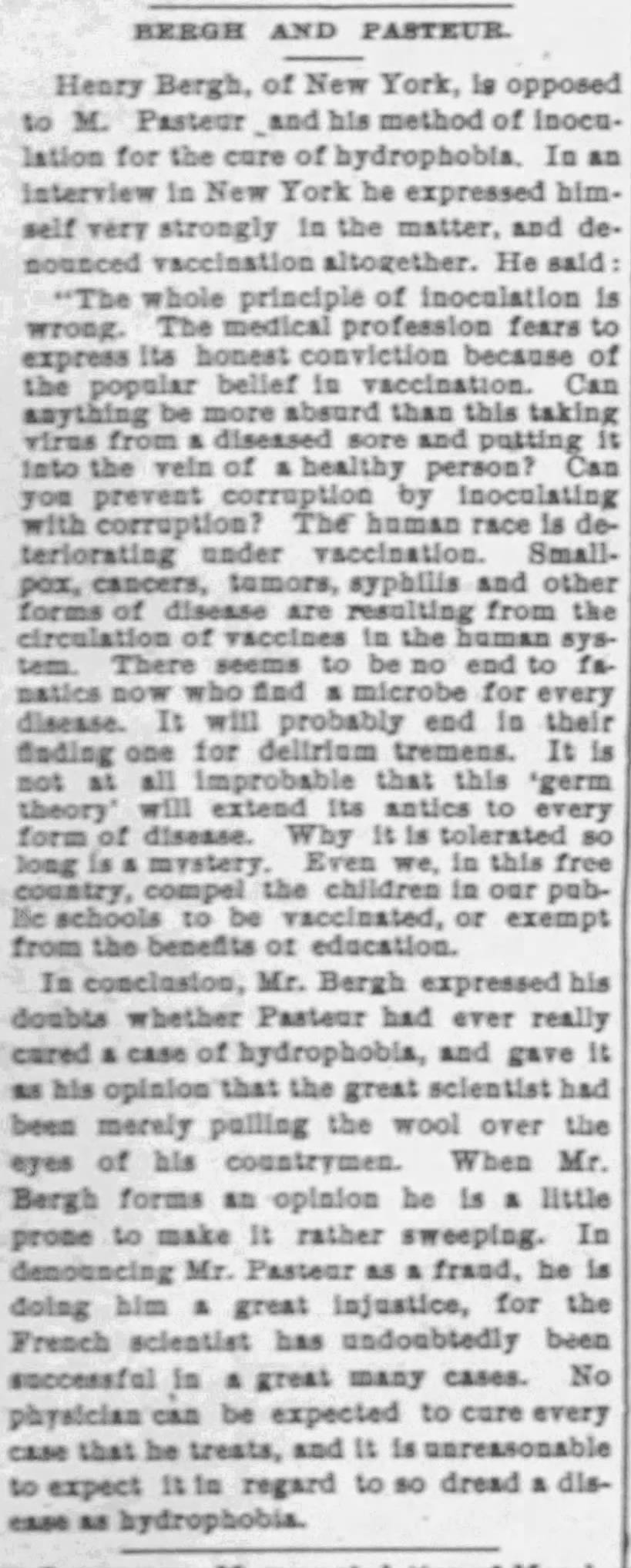
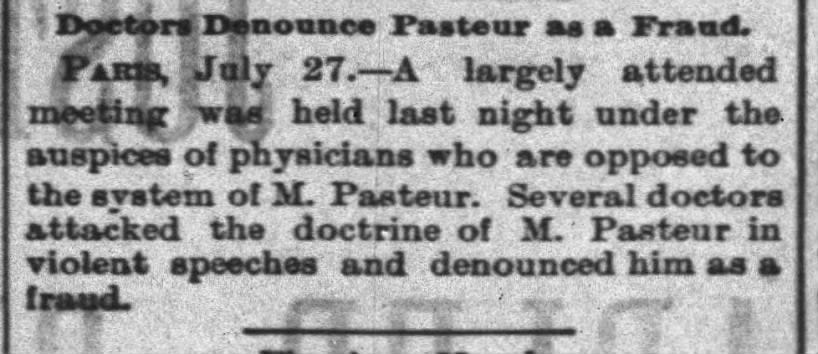


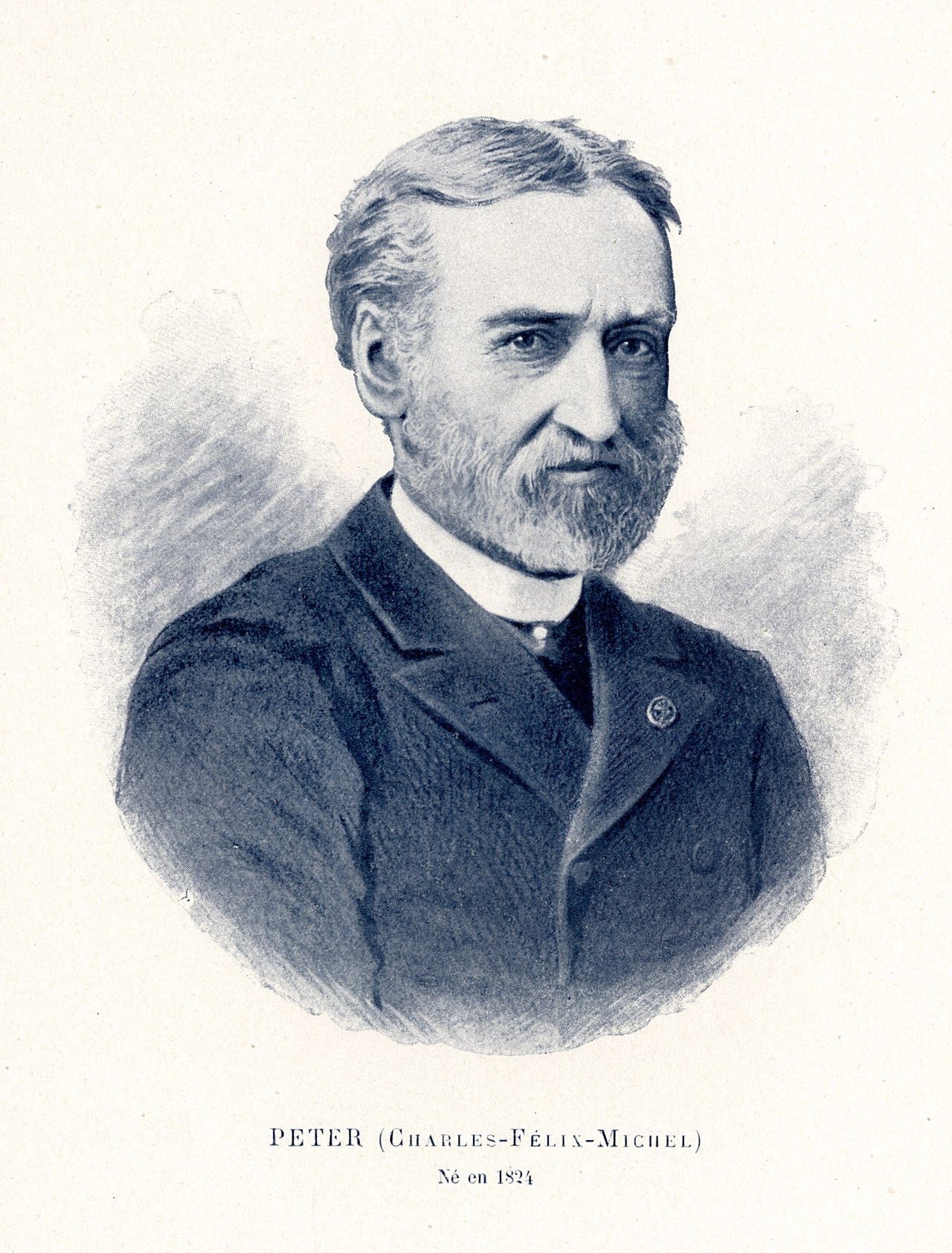









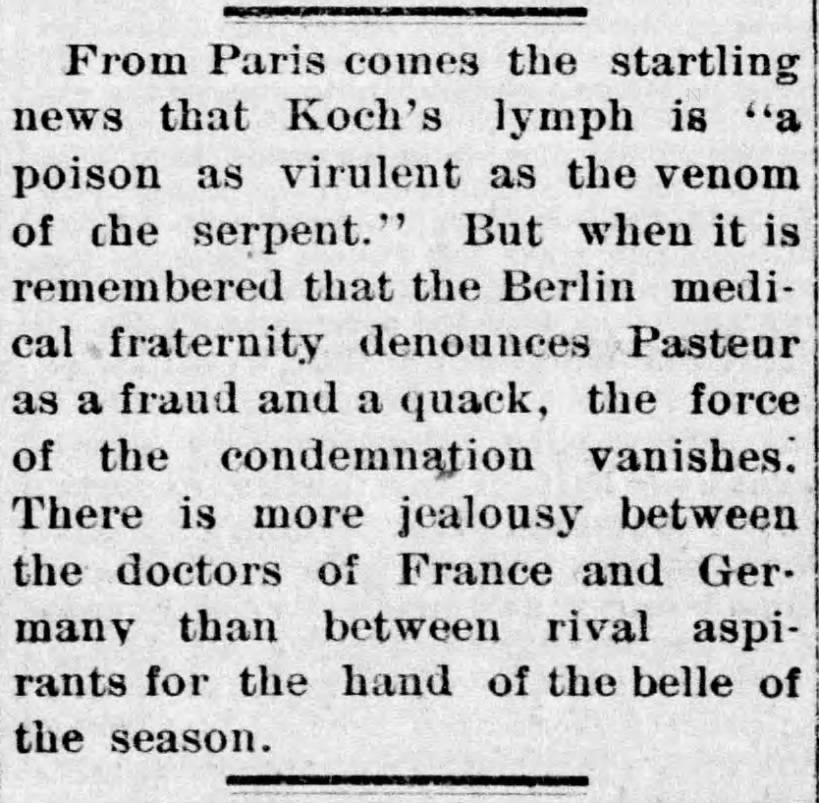
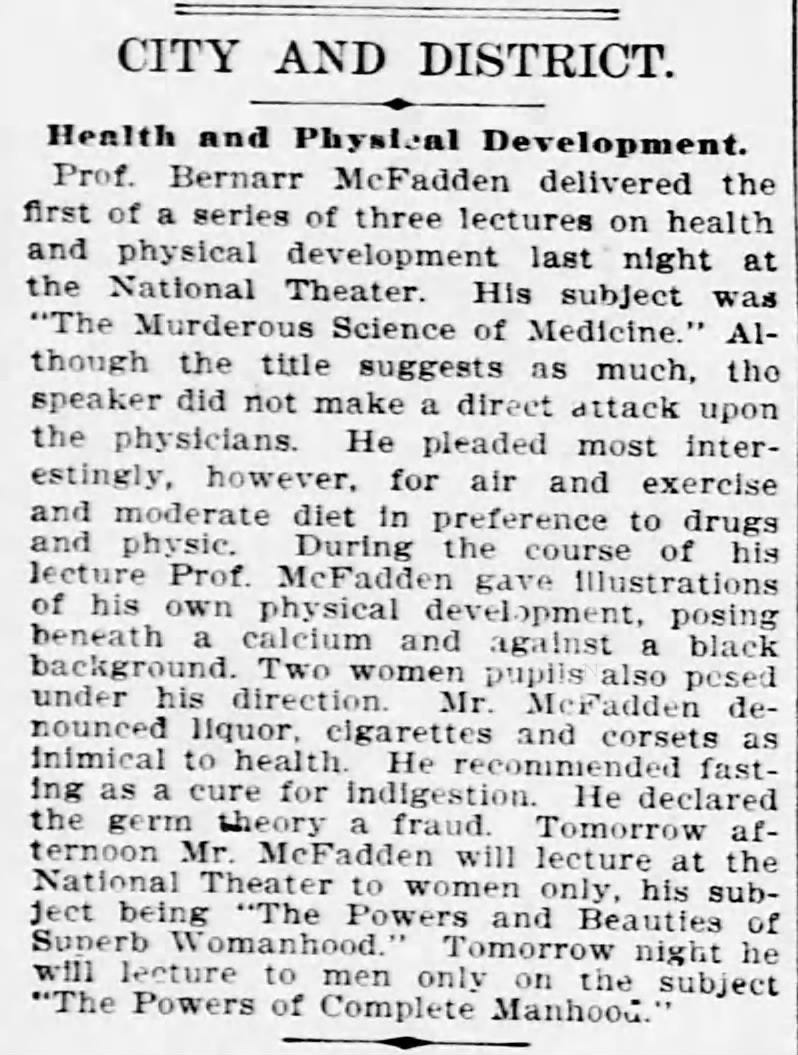


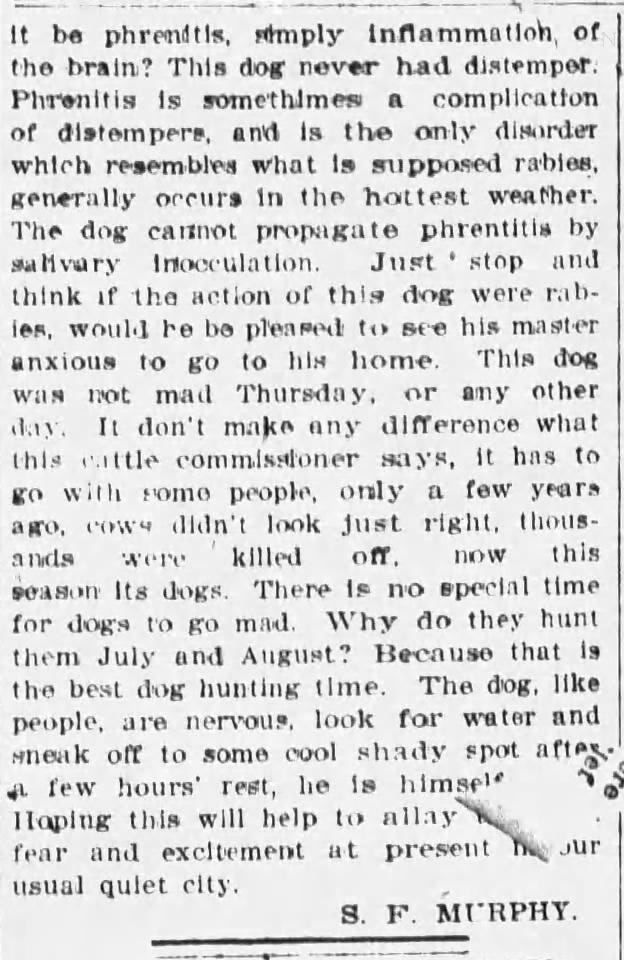
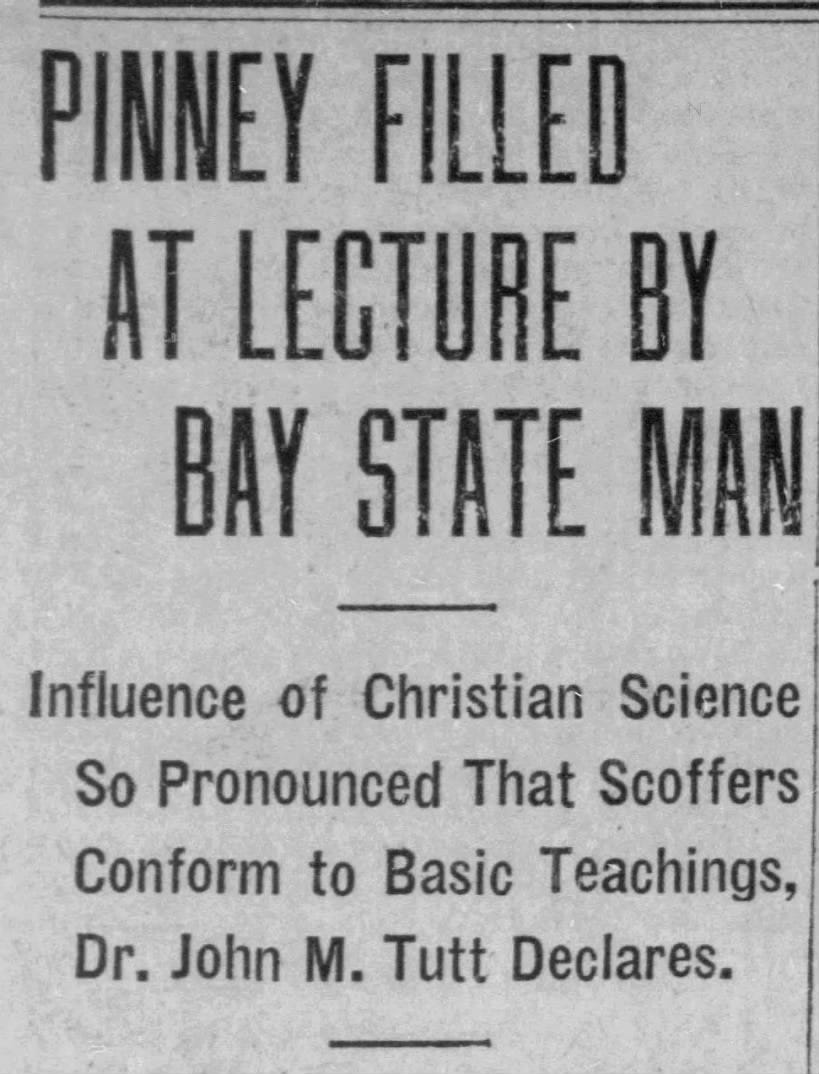

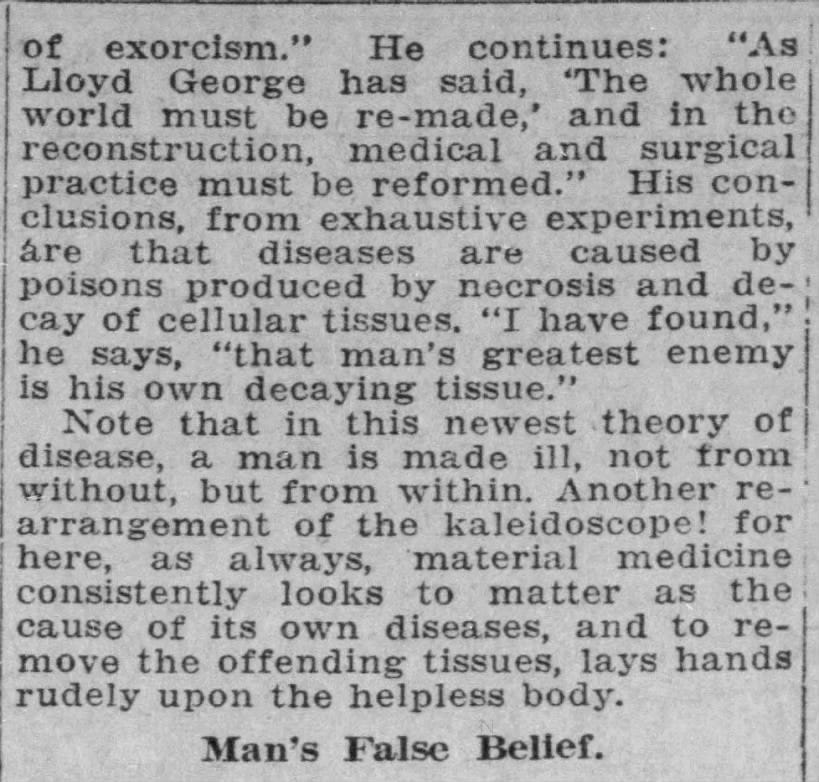


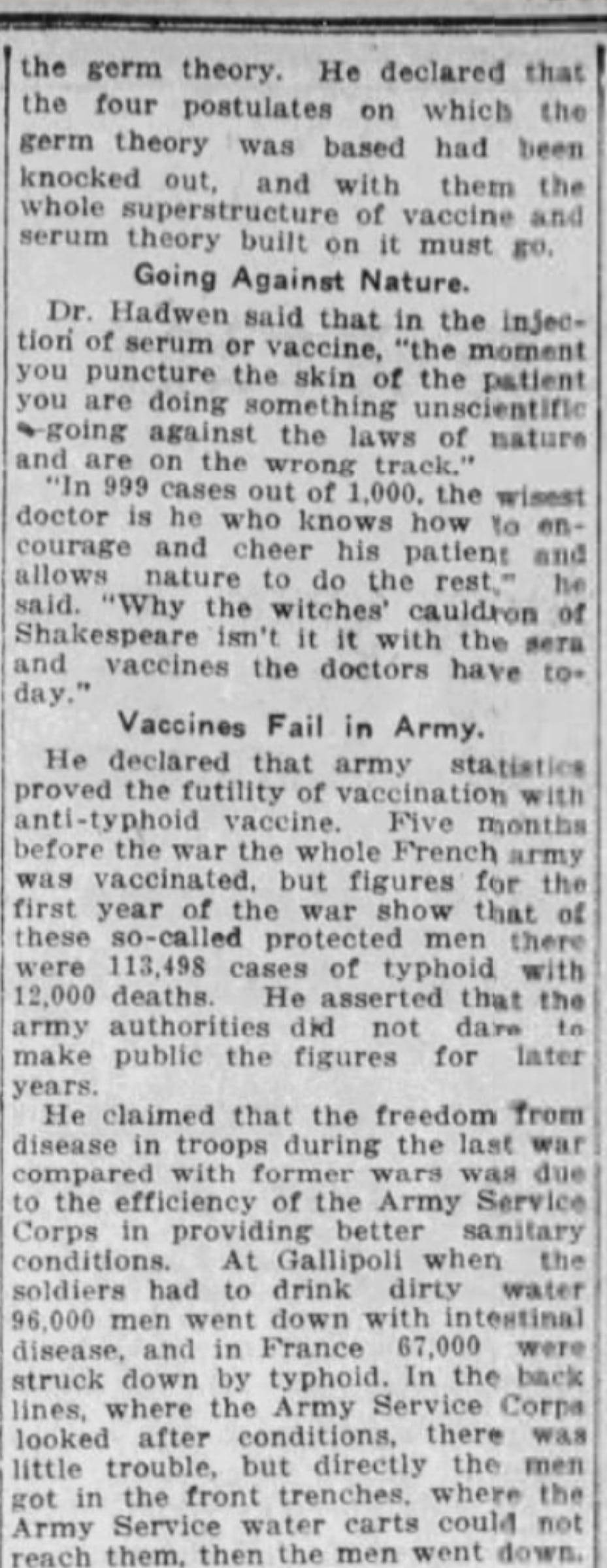







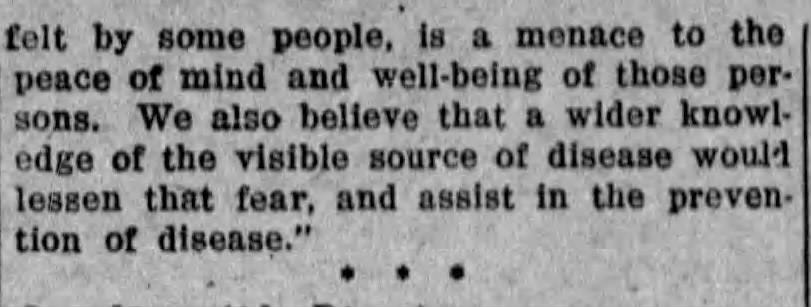
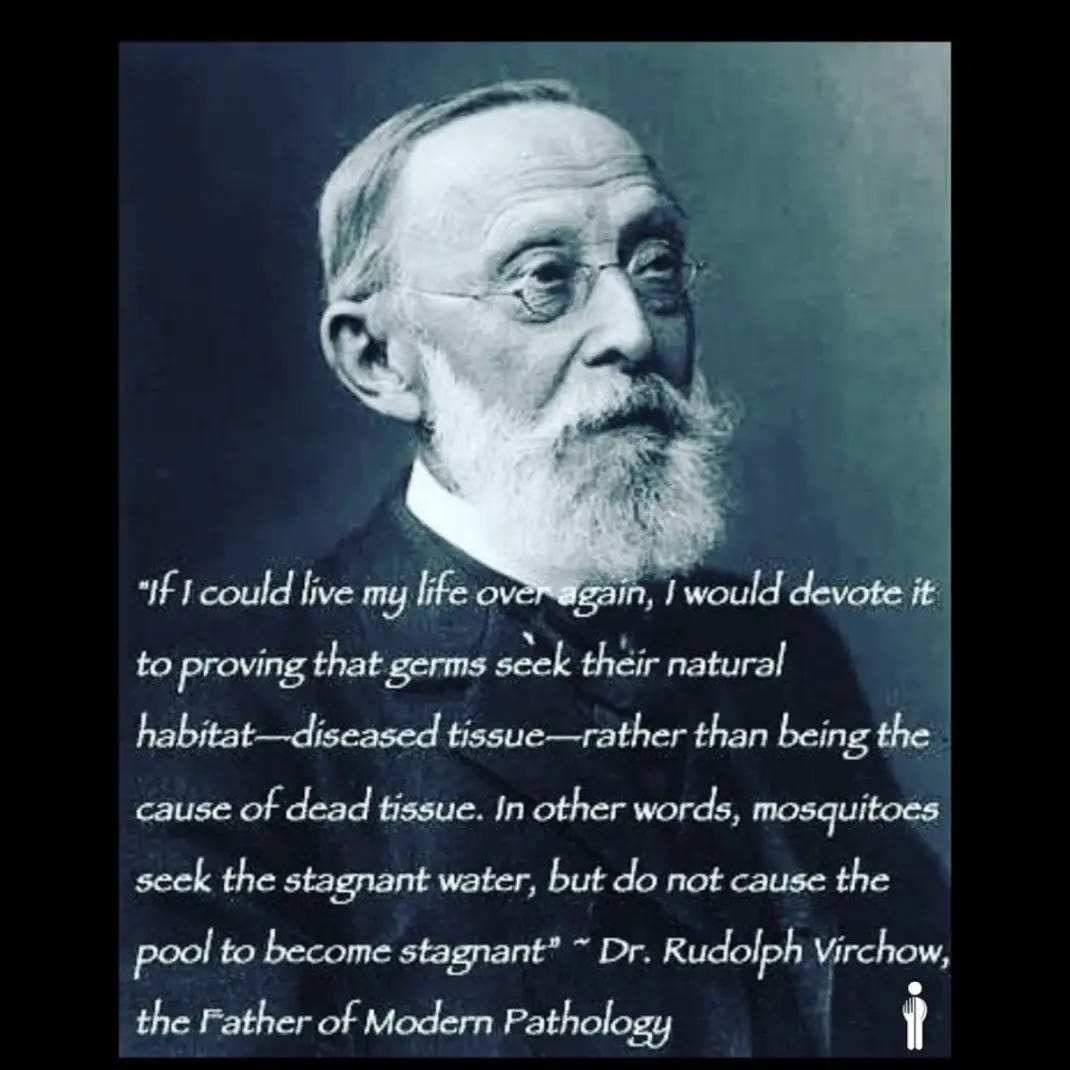

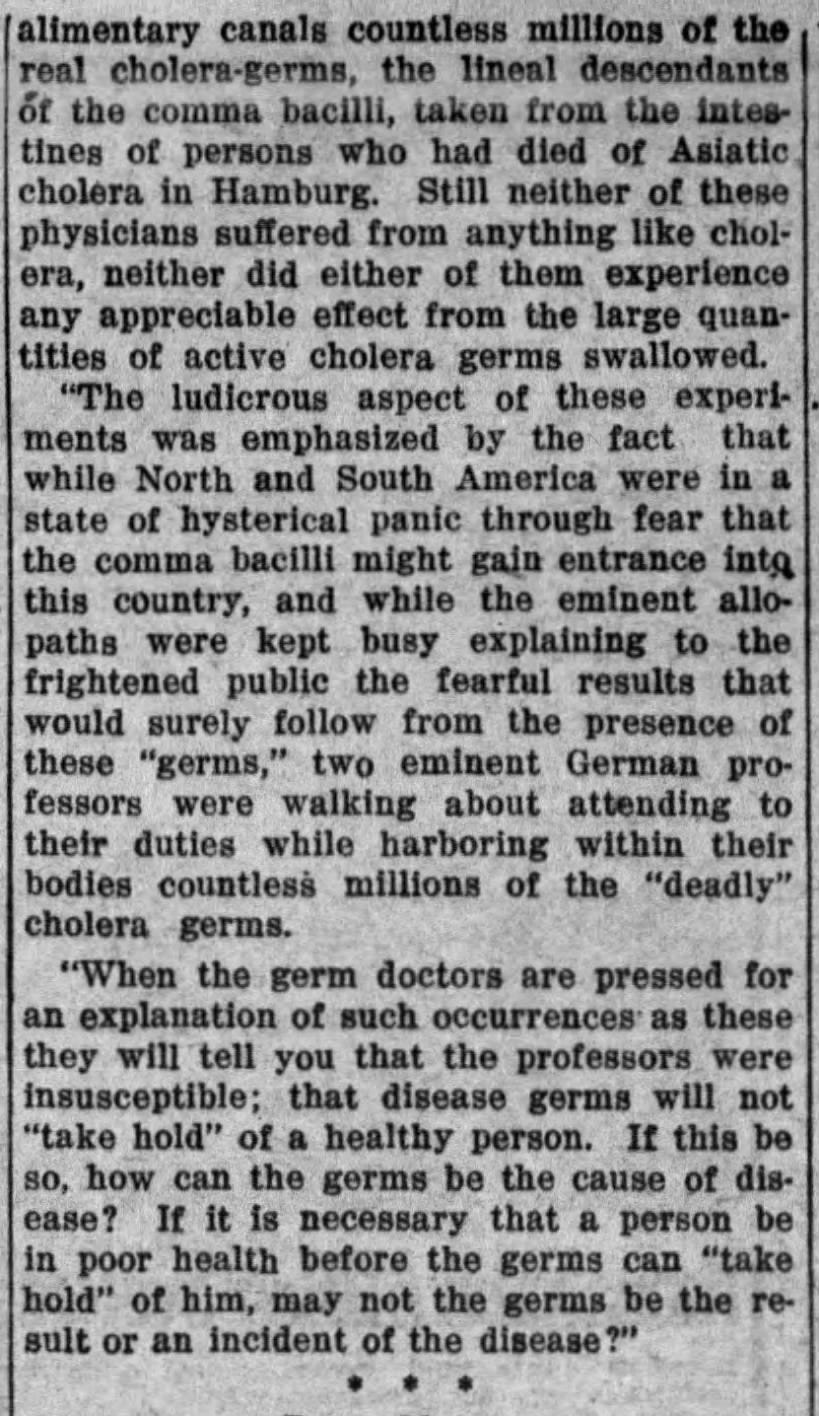

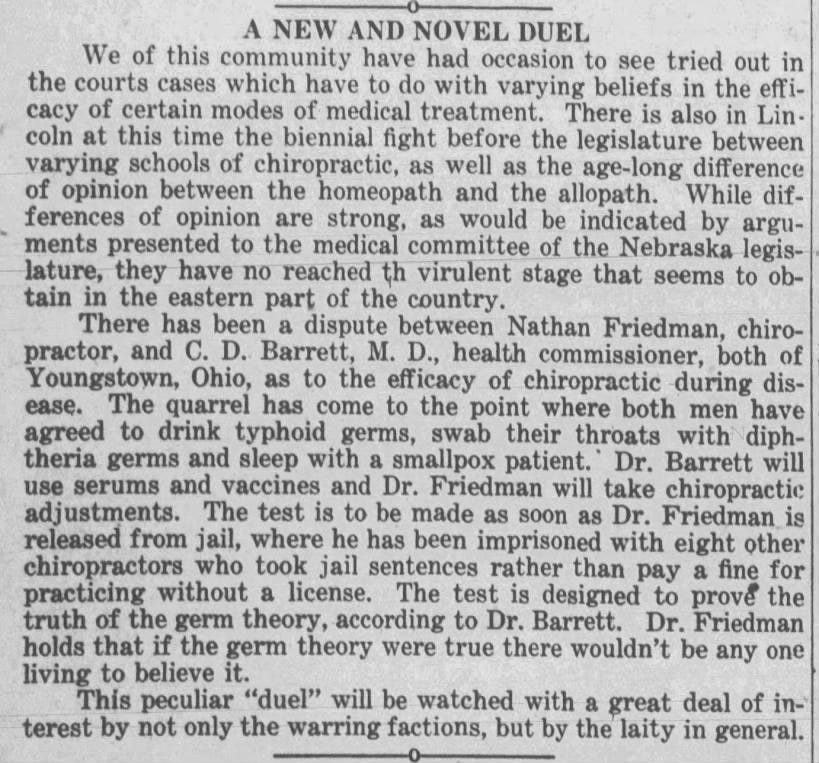

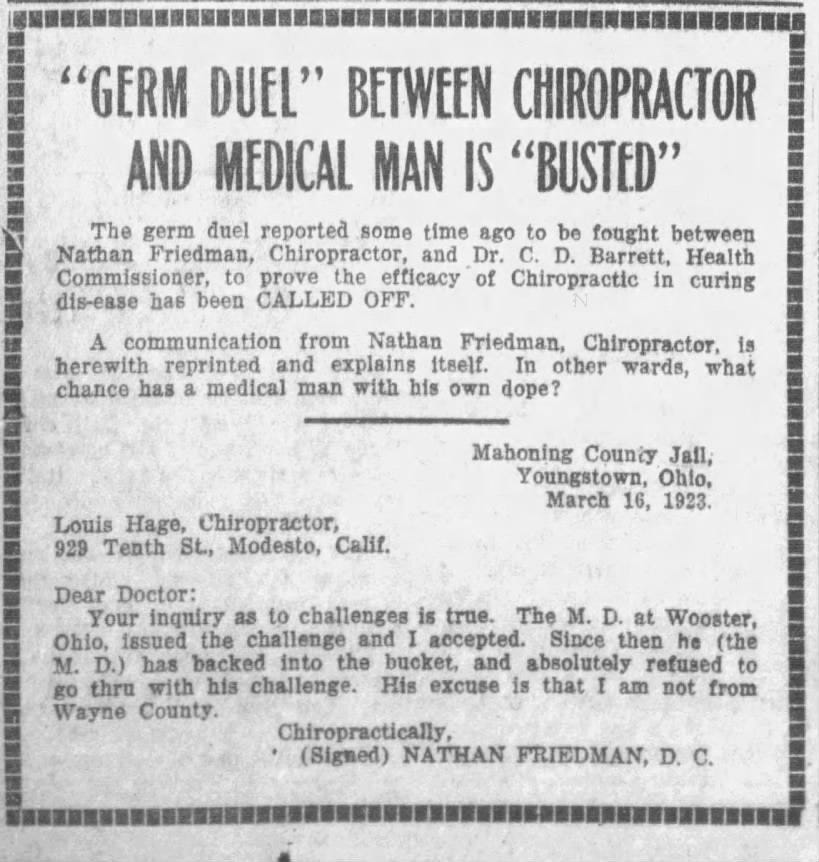



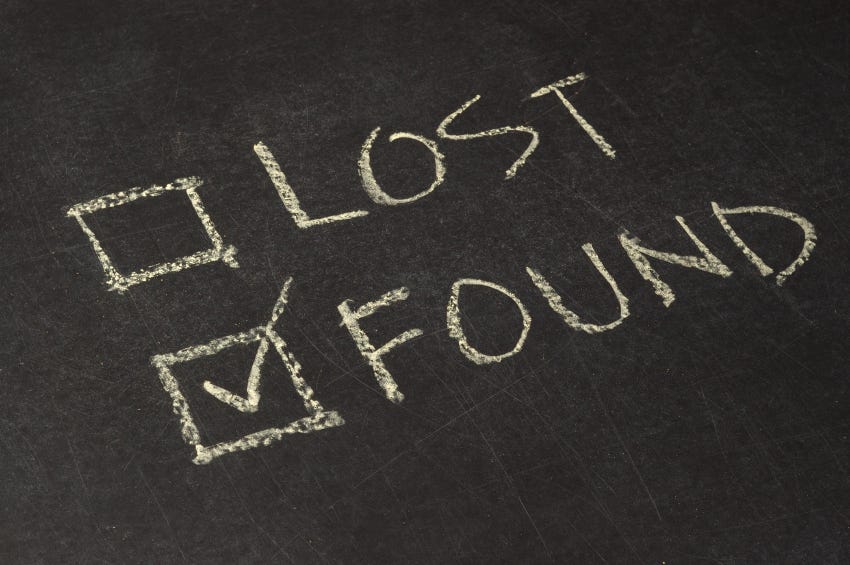



Incredible, Mike. Such a comprehensive expose through the early literature.
All too familiar - love "Quackery always has one shuffle left."
Dr. Hadwen then pointed out the fallacious thinking regarding “protection” from vaccination. If the vaccines provide “immunity,” one should not need to be re-vaccinated again and again and again until they die. However, this is exactly what was being proposed and carried out as the vaccines did not actually prevent the diseases they were meant to protect against. He pointed out how easy it is to proclaim that a vaccine is “effective” if one receives the vaccine and goes throughout life without getting the disease. This has been “the sheet anchor of every marketplace quack from time immoral.” During the plague, people were told that wearing a live toad around their necks protected them from disease. When one did not come down with disease, they were assured that it was because of the toad that they were protected. If one did take to disease in a mild form, they were told that without the toad, the disease would have been much more severe. If one had severe disease while wearing the toad, they were assured that without the toad, they would have died. If one did succumb to the disease, it was said that they must have had the wrong toad, or wore it the wrong way, or the toad was either put on too soon or too late, or some other excuse. As Dr. Hadwen succinctly stated, “Quackery always has one shuffle left.”
Great work. This needs to be spread far and wide. The average person today has no clue about any of this. I keep trying to point some of the people who are very much aware of the Covid scam in this direction, as it seems to be a natural segue to the deeper fallacy of germ theory and its inherent financial incentives, yet it's not as easy to research as what's been forced fed us for the past few years from all angles. Your work seems really important for this. Thank you